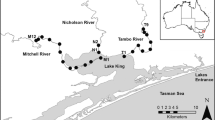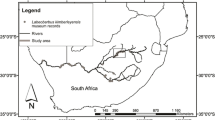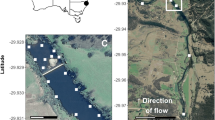Abstract
The increase in anthropogenic stress on river ecosystems is of growing concern globally as demand for water increases and freshwater ecosystem degradation occurs. Understanding how the species respond to these stressors is important to manage ecosystem functioning, the conservation of species and the ecosystem services they provide. We used radio telemetry to determine the temporal movement of 19 tigerfish Hydrocynus vittatus and 11 lowveld large-scale yellowfish Labeobarbus marequensis, and their responses to environmental factors in two river systems, the Crocodile and the Olifants-Letaba rivers in the Kruger National Park, South Africa, from September 2011 to January 2012 and May 2018 to December 2019, respectively. Remote telemetry techniques were used to collect data from activity sensors attached to fish. Activity (movement count per hour) from both species showed diurnal behaviour. The data analyses using generalised mixed models with random effects showed that both species responded similarly to environmental factors, with differing significance in this response. Flow was negatively correlated, and water temperature positively correlated to activity. Both variables consistently showed higher significant responses than the other environmental variables assessed. Both fish species’ relationship to changes in flow and temperature can contribute to managing anthropogenic stressors and regulating flows in rivers. Further studies of this would significantly contribute to conserving these and other fish species in Kruger National Park.





Similar content being viewed by others
Availability of data and material
Data for this study are available on request from the authors but belong to the University of KwaZulu-Natal.
References
Bates D, Maechler M, Bolker B, Walker S (2014) lme4: linear mixed-effects models using Eigen and S4. R package version 1.1–7. Retrieved June, 2019, from http://cran.r-project. org/package=lme4
Bartoń K (2013) MuMIn: multi-model inference, R package version 1.9.13. http://CRAN.R-project.org/package=MuMIn. Accessed 10 October 2019
Beltramino LE, Venerus LA, Trobbiani GA, Ciancio WRP, JE, (2019) Activity budgets for the sedentary Argentine sea bass Acanthistius patachonicus inferred from accelerometer data loggers. Austral Ecol 44:397–408
Brand M, Maina J, Mander M, O’Brien G (2009) Characterisation of the social and economic value of the use and associated conservation of the yellowfishes in the Vaal River. Water Research Commission, Pretoria, South Africa
Broell F, Burnell C, Taggart CT (2016) Measuring abnormal movements in free-swimming fish with accelerometers: implications for quantifying tag and parasite load. J Exp Biol 219:695–705
Burnett MJ, O’Brien GC, Jacobs FJ, Jewitt G, Downs CT (2021a) Fish telemetry in African inland waters and its use in management: a review. Rev Fish Biol Fisheries 31:337–357. https://doi.org/10.1007/s11160-021-09650-2
Burnett MJ, O’Brien GC, Jewitt G, Downs CT (2021b) Temporal and spatial ecology of an iconic Labeobarbus spp. in a socio-economically important river. Environ Biol Fishes 104:1103–1119.
Burnett MJ, O’Brien G C, Jacobs F J, Botha F, Jewitt G, Downs CT (2020) Southern African inland fish tracking programme (FISHTRAC), to evaluate the ecological consequences of multiple water resource stressors, remotely and in real time. Ecological Indicators 111, 106001
Burnett M, O’Brien G, Wepener V, Pienaar D (2018) The spatial ecology of adult Labeobarbus marequensis and their response to flow and habitat variability in the Crocodile River, Kruger National Park. African J Aquatic Sci 43:375–384. https://doi.org/10.2989/16085914.2018.1517077
Burnham KP, Anderson DR (2002) Model selection and multimodel inference: a practical information-theoretic approach. Springer, USA, p 488
Chevin LM, Lande R, Mace GM (2010) Adaptation, plasticity, and extinction in a changing environment: towards a predictive theory. PLoS Biol 8:4
Chovanec A, Hofer R, Schiemer F (2003) Fish as bioindicators. In: Markett BA, Breure AM, Zechmeister HG (eds) (2003) Trace metals and other contaminants in the environment, vol 6. Elsevier, New York, pp 639–676
Cooke SJ, Brownscombe JW, Raby GD, Broell F, Hinch SG, Clark TD, Semmens JM (2016) Remote bioenergetics measurements in wild fish: opportunities and challenges. Comp Biochem Physiol a: Mol Integr Physiol 202:23–37. https://doi.org/10.1016/j.cbpa.2016.03.022
De Sousa DNR, Mozeto AA, Carneiro RL, Fadini PS (2014) Electrical conductivity and emerging contaminant as markers of surface freshwater contamination by wastewater. Sci Total Environ 484:19–26
Dickens C, Smakhtin V, McCartney M, O’Brien G, Dahir L (2019) Defining and quantifying national-level targets, indicators and benchmarks for management of natural resources to achieve the sustainable development goals. Sustainability 11:462. https://doi.org/10.3390/su11020462
Douglas B, Martin M, Ben B, Steve W (2015) Fitting linear mixed-effects models using lme4. J Stat Softw 67:1–48. https://doi.org/10.18637/jss.v067.i01
Plessis Du A (2019) Evaluation of Southern and South Africa’s freshwater resources A Plessis Du Eds (2019) Water as an Inescapable Risk Springer Cham 147 172 978-3-030-03185-5. https://doi.org/10.1007/978-3-030-03186-2_7
Edwards S, Noack J, Heyns L, Rodenwoldt D (2020) Are camera traps a reliable method for estimating activity patterns? A case study comparing technologies for estimating brown hyaena activity curves. Remote Sens Ecol Conserv 2:175. https://doi.org/10.1002/rse2.175
Flitcroft RL, Lewis SL, Arismendi I, LovellFord R, Santelmann MV, Safeeq M, Grant G (2016) Linking hydroclimate to fish phenology and habitat use with ichthyographs. PLoS ONE 11(1–12):e0168831. https://doi.org/10.1371/journal.pone.0168831
Fouché PSO (2009) Aspects of the ecology and biology of the Lowveld largescale yellowfish (Labeobarbus marequensis, Smith, 1843) in the Luvuvhu River, Limpopo River System, South Africa. PhD dissertation. University of Limpopo, Polokwane, South Africa
Fuchs NT, Caudill CC (2019) Classifying and inferring behaviors using real-time acceleration biotelemetry in reproductive steelhead trout (Oncorhynchus mykiss). Ecol Evol 9:11329–11343
Gaigher I (1970) Ecology of the tigerfish. Hydrocynus Vittatus Zoology Africana 5:211–227
Gerber R, Howatson G, Greenfield R, Wagenaar I, Smit N (2017) Physiological response to angling of Africa’s premier freshwater angling species, the tigerfish Hydrocynus vittatus. African Zoology 52:91–98
Gerber R, Smit NJ, van Vuren JH, Ikenaka Y, Wepener V (2018) Biomarkers in tigerfish (Hydrocynus vittatus) as indicators of metal and organic pollution in ecologically sensitive subtropical rivers. Ecotoxicol Environ Saf 157:307–317
Gerber R, Smit NJ, van Vuren JH, Nakayama SM, Yohannes YB, Ikenaka Y, Ishizuka M, Wepener V (2016) Bioaccumulation and human health risk assessment of DDT and other organochlorine pesticides in an apex aquatic predator from a premier conservation area. Sci Total Environ 550:522–533
Gigiano CL (1997) An ecological study on the tigerfish Hydrocynus vittatis in the Olifants and Letaba rivers with special reference to artificial reproduction. MSc thesis, Rand Afrikaans University. Johannesburg, South Africa
Godin JG (1997) Behavioural ecology of teleost fishes. Oxford University Press, Oxford
Graham MH (2003) Confronting multicollinearity in ecological multiple regression. Ecology 84:2809–2815
Gretener B (1985) The river Fyrisån, transportation and deposition of suspended sediment. Geogr Ann Ser B 67:139–143
Harris JH (1995) The use of fish in ecological assessments. Austral Ecol 20:65–80
Harrison PM, Keeler RA, Robichaud D, Mossop B, Power M, Cooke SJ (2019) Individual differences exceed species differences in the movements of a river fish community. Behav Ecol 30:1289–1297
Impson ND, Bills IR, Wolhuter L (2008) Technical report on the state of yellowfishes in South Africa. Water research commission, Pretoria, South Africa. ISBN 978–1–77005–719–7
Jacobs FJ, Naesje TF, Ulvan EM, Weyl OLF, Tiyeho D, Hay CJ, O’Brien GC, Downs CT (2019) Implications of the movement behaviour of African tigerfish Hydrocynus vittatus for the design of freshwater protected areas. J Fish Biol 2019:1–9
Jepsen N, Schreck C, Clements S, Thorstad EB (2004) A brief discussion on the 2% tag/body weight rule of thumb. Aquatic Telemetry Advances and Applications. FAO-COISPA, Rome 255–259.
Jepsen N, Thorstad EB, Havn T, Lucas MC (2015) The use of external electronic tags on fish: an evaluation of tag retention and tagging effects. Animal Biotelemetry 3:49. https://doi.org/10.1186/s40317-015-0086-z
Junk WJ, Wantzen KM (2006) Flood pulsing and the development and maintenance of biodiversity in floodplains. In: Batzer DP, Sharitz RR (eds) (2006) Ecology of freshwater and estuarine wetlands, 1st edn. University of California Press, Berkeley, California, pp 407–435
Kleynhans CJ (1999) The development of a fish index to assess the biological integrity of South African rivers. Water SA 25:265–278. https://doi.org/10.1111/1365-2664.12542
Klinard NV, Matley JK. (2020) Living until proven dead: addressing mortality in acoustic telemetry research. Reviews in Fish Biology and Fisheries, 1–5.
Kusangaya S, Toucher MLW, van Garderen EA (2018) Evaluation of uncertainty in capturing the spatial variability and magnitudes of extreme hydrological events for the uMngeni catchment, South Africa. J Hydrol 557:931–946
Lucas MC, Baras E (2000) Methods for studying spatial behaviour of freshwater fishes in the natural environment. Fish Fish 1:283–316. https://doi.org/10.1046/j.1467-2979.2000.00028.x
Leibold MA, McPeek MA (2006) Coexistence of the niche and neutral perspectives in community ecology. Ecology 87:1399–1410
Mabunda D, Pienaar DJ, Verhoef J (2003) The Kruger National Park: a century of management and research. In: Du Toit JT, Rogers KH, Biggs H (eds) (2003) The Kruger Experience, ecology and management of savanna heterogeneity. Island Press, Washington, pp 3–21
Marconi V, McRae L, Baumgartner LJ, Brink K, Claussen JE, Cooke SJ, Darwall W, Eriksson BK, Garcia de Leaniz C, Hogan Z, Royte J, Silva LGM, Thieme ML, Tickner D, Waldman J, Wanningen H, Weyl OLF, Berkhuysen A. (2020) The living planet index (LPI) for migratory freshwater fish - technical report. World Fish Migration Foundation, The Netherlands.
Metcalfe JD, Wright S, Tudorache C, Wilson RP (2016) Recent advances in telemetry for estimating the energy metabolism of wild fishes. J Fish Biol 88:284–297
Muller M, Zandamela H (2018) Can integrated infrastructure investment plans contribute to more effective public spending? The case of Mozambique. Dev South Afr 35:511–526
Nel JL, Roux DJ, Maree G, Kleynhans CJ, Moolman J, Reyers B, Rouget M, Cowling RM (2007) Rivers in peril inside and outside protected areas: a systematic approach to conservation assessment of river ecosystems. Divers Distrib 13:341–352. https://doi.org/10.1111/j.1472-4642.2007.00308.x
O’Brien GC, Bulfin JB, Husted A, Smit NJ (2012) Comparative behavioural assessment of an established and a new tigerfish Hydrocynus vittatus population in two man-made lakes in the Limpopo River catchment, southern Africa. Afr J Aquat Sci 37:253–263. https://doi.org/10.2989/16085914.2012.723196
O’Brien GC, Dickens C, Hines E, Wepener V, Stassen R, Quayle L, Fouchy K, MacKenzie J, Graham PM, Landis WG (2018) A regional-scale ecological risk framework for environmental flow evaluations. Hydrol Earth Syst Sci 22:957–975. https://doi.org/10.5194/hess-22-957-2018
O’Brien GC, Ross M, Hanzen C, Dlamini V, Petersen R, Diedericks GJ, Burnett MJ (2019) River connectivity and fish migration considerations in the management of multiple stressors in South Africa. Mar Freshw Res 70:1254–1264. https://doi.org/10.1071/MF19183
Oksanen J, Kindt R, Legendre P, O’Hara B, Stevens MH, Oksanen MJ, Suggests MA (2007) The Vegan Package Community Ecology Package 10:631–637
Pienaar UdeV (1978) The Freshwater fishes of the Kruger National Park. Sigma Press, Pretoria.
Pinsky ML (2019) Species coexistence through competition and rapid evolution. Proc Natl Acad Sci 116:2407–2409
Pollard S, Mallory S, Riddell E, Sawunyama T (2012) Towards improving the assessment and implementation of the reserve: real-time assessment and implementation of the ecological reserve. Water Research Commission, Pretoria, South Africa.
Ramesh T, Downs CT, O’Brien GC (2018) Movement response of Orange-Vaal largemouth yellowfish (Labeobarbus kimberleyensis) to water quality and habitat features in the Vaal River, South Africa. Environ Biol Fishes 101:997–1009. https://doi.org/10.1007/s10641-018-0754-y
Ramulifho P, Ndou E, Thifhulufhelwi R, Dalu T (2019) Challenges to implementing an environmental flow regime in the Luvuvhu River Catchment, South Africa. Int J Environ Res Public Health 16:3694
Riddell ES, Govender D, Botha J, Sithole H, Petersen RM, Shikwambana P (2019) Pollution impacts on the aquatic ecosystems of the Kruger National Park. South Africa Scientific African 6:195
Rivers-Moore NA, Dallas HF, Morris C (2013) Towards setting environmental water temperature guidelines: a South African example. J Environ Manage 128:380–392
Rivers-Moore NA, Ellender BR, Weyl OLF (2019) Modelling expected trout ranges under current and future water temperature regimes in the Eastern Cape, South Africa. Afr J Aquat Sci 44:35–42
Rodell M, Famiglietti JS, Wiese DN, Reager JT, Beaudoing HK, Landerer FW, Lo MH (2018) Emerging trends in global freshwater availability. Nature 557:651
Ross-Gillespie V, Picker MD, Dallas HF, Day JA (2018) The role of temperature in egg development of three aquatic insects Lestagella penicillata (Ephemeroptera), Aphanicercella scutata (Plecoptera), Chimarra ambulans (Trichoptera) from South Africa. J Therm Biol 71:158–170
Roux F, Steyn G, Hay C, Wagenaar I (2018) Movement patterns and home range size of tigerfish (Hydrocynus vittatus) in the Incomati River system, South Africa. Koedoe 60:1–13. https://doi.org/10.4102/koedoe.v60i1.1397
RStudio Team (2015) RStudio: integrated development for R. RStudio, Inc., Boston, MA URL http://www.rstudio.com/.
Sabater S, Elosegi A, Ludwig R (2019) Defining multiple stressor implications. In: Sabater S, Elosegi A, Ludwig R. (Eds.), (2019). Multiple Stressors in River Ecosystems: Status, Impacts and Prospects for the Future. Elsevier, New York. pp. 1–22.
Saraiva Okello AML, Masih I, Uhlenbrook S, Jewitt GPW, Van der Zaag P, Riddell E (2015) Drivers of spatial and temporal variability of streamflow in the Incomati River basin. Hydrol Earth Syst Sci 19:657–673
Skelton PH (2016) Name changes and additions to the southern African freshwater fish fauna. Afr J Aquat Sci 41:345–351. https://doi.org/10.2989/16085914.2016.1186004
Skelton PH (2000) Flagships and fragments—perspectives on the conservation of freshwater fishes in southern Africa. Afr J Aquat Sci 25:37–42. https://doi.org/10.2989/160859100780177929
Smit NJ, Gerber R, Greenfield R, Howatson G (2016) Physiological response of one of South Africa’s premier freshwater sport angling species, the Orange-Vaal smallmouth yellowfish Labeobarbus aeneus, to catch-and-release angling. African Zoology 51:61–67
Smit NJ, Wepener V, Vlok W, Wagenaar GM, van Vuuren JHJ (2013) Conservation of tigerfish, Hydrocynus vittatus, in the Kruger National Park with the emphasis on establishing the suitability of the water quantity and quality requirements for the Olifants and Luvuvhu rivers. Water Research Commission, Pretoria, South Africa.
Sonamzi B, Burnett M, Petersen R, O’Brien G, Downs CT (2020) Assessing the effect of tagging and the vulnerability to predation in tigerfish (Hydrocynus vittatus), Castelnau 1861) in a water-stressed system using telemetry methods. Koedoe 62:1–12
Steyn GJ, Gagiano CL, Deacon AR, du Preez HH (1996) Notes on the induced reproduction and development of the tigerfish, Hydrocynus vittatus (Characidae), embryos and larvae. Environ Biol Fishes 47:387–398
Tamburello N, Côté IM, Dulvy NK (2015) Energy and the scaling of animal space use. Am Nat 186:196–211
Thiem JD, Wooden IJ, Baumgartner LJ, Butler GL, Forbes J, Taylor MD, Watts RJ (2018) Abiotic drivers of activity in a large, free-ranging, freshwater teleost, Murray cod (Maccullochella peelii). PloS One, 13, 0198972
Thompson MY, Brandes D, Kney AD (2012) Using electronic conductivity and hardness data for rapid assessment of stream water quality. J Environ Manage 104:152–157
Vlok W, Engelbrecht JS (2000) Some aspects of the ecology of the Groot Letaba River in the Northern Province, South Africa. Afr J Aquat Sci 25:76–83
Ward AJ, Webster MM, Hart PJ (2006) Intraspecific food competition in fishes. Fish Fish 7:231–261
Welch HE (1968) Relationships between assimilation efficiencies and growth efficiencies for aquatic consumers. Ecology 49:755–759
Wepener V (2008) Application of active biomonitoring within an integrated water resources management framework in South Africa. S Afr J Sci 104:367–373
Wepener V, van Dyk C, Bervoets L, O’Brien G, Covaci A, Cloete Y (2011) An assessment of the influence of multiple stressors on the Vaal River, South Africa. Physics and Chemistry of the Earth, Parts a/b/c 36:949–962. https://doi.org/10.1016/j.pce.2011.07.075
Weyl OL, Chakona A (2020) Journal of Fish Biology special issue on The Biology and Ecology of African Freshwater Fishes. J Fish Biol 96:1075–1076
Woldegiorgis BT, Van Griensven A, Bauwens W (2018) Explicit incipient motion of cohesive and non-cohesive sediments using simple hydraulics. Depositional Record 4:78–89
Acknowledgements
We are grateful to the University of KwaZulu-Natal (ZA) and the University of Mpumalanga (ZA) for their support. Further, the support from South African National Parks personal, Bruce Leslie and Danie Pienaar, for their valuable input on site selection and access is gratefully acknowledged.
Funding
We thank the University of KwaZulu-Natal (UKZN, ZA), the Water Research Commission (ZA, WADER programme), IdeaWild (USA), the UKZN Centre for Water Resource Research (ZA), the UKZN Centre for Functional Biodiversity (ZA), Umgeni Water (ZA), the UKZN Durban Research Action Project (D’RAP) and the National Research Foundation (NRF, ZA, Grant 98404) and the NRF, BRICS - Multilateral Joint Science and Technology Research Collaboration study titled, ‘Global and local water quality monitoring by multimodal sensor systems’, (Grant 116022), for funding and support for the project.
Author information
Authors and Affiliations
Contributions
All authors conceived the research idea. GOB, VW, and CTD sought funding. MB, BSS, and GOB collected the data. MB analysed the data. MB drafted the manuscript, and all authors provided comments and revisions to the manuscript.
Corresponding author
Ethics declarations
Ethics approval
Ethics approval was granted by the University of KwaZulu-Natal Animal Research Ethics Committee (number: AREC 070 017D). Relevant permits were obtained from the conservation bodies.
Conflict of interest
The authors declare no competing interests.
Additional information
Publisher's Note
Springer Nature remains neutral with regard to jurisdictional claims in published maps and institutional affiliations.
Rights and permissions
About this article
Cite this article
Burnett, M.J., O’Brien, G.C., Sonamzi, B. et al. Temporal movement of free-swimming fishes and their response to environmental variables in some of the rivers of Kruger National Park, South Africa. Environ Biol Fish 105, 19–35 (2022). https://doi.org/10.1007/s10641-021-01178-5
Received:
Accepted:
Published:
Issue Date:
DOI: https://doi.org/10.1007/s10641-021-01178-5




